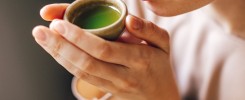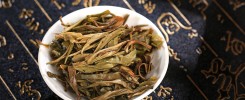If you’ve ever stood in front of a tea shelf or browsed online and wondered how to pronounce Pu-erh tea, you’re not alone. This ancient Chinese tea, known for its earthy flavor and remarkable aging potential, often leaves people unsure of how to say its name. But learning the correct pronunciation isn’t just about sounding authentic—it’s also about connecting with the rich culture and tradition behind every cup.
Table of Contents
The Correct Pronunciation
Let’s start with the basics. The correct pronunciation of Pu-erh tea is “poo-air”. Two syllables, spoken smoothly and naturally. The name originates from Pu’er (普洱), a region in Yunnan Province, China, which has produced this type of fermented tea for centuries. In Mandarin Chinese, it’s pronounced roughly as “poo-ahr,” with the second syllable being soft and subtle. The English adaptation “poo-air” has simply made it easier for global tea drinkers to say.
You might also see it written as “Puer,” “Pu’er,” or even “Pu-er.” These variations all refer to the same tea, though “Pu-erh” has become the most common form in the Western market.
Why Pronunciation Reflects Understanding
Pronouncing Pu-erh correctly is more than linguistic accuracy—it reflects respect for the culture and heritage that gave birth to this remarkable tea. Just as wine enthusiasts learn to pronounce “Cabernet Sauvignon” or “Château Margaux,” serious tea lovers can show the same appreciation by learning how to say Pu-erh properly.
Understanding how to say it also helps you navigate the world of tea with more confidence. When you walk into a tea shop or attend a tasting event, being able to say “poo-air” clearly and correctly immediately sets you apart as someone who truly values what’s in the cup.
A Tea with Deep Roots
Pu-erh tea has one of the most fascinating journeys in the tea world. Unlike green or black tea, Pu-erh undergoes post-fermentation, meaning it continues to age and develop flavor long after it’s been processed. The microbes within the tea transform its taste over time—just like aged cheese or fine wine.
Originally traded along the Ancient Tea Horse Road, Pu-erh was compressed into bricks or cakes for easier transport across mountains and borders. As it traveled, the tea naturally fermented, gaining depth, smoothness, and that signature earthy aroma. This aging process gave Pu-erh its unique identity, which still defines it today.
Sheng vs. Shou Pu-erh
Once you can pronounce the name, you’ll want to understand its two main varieties:
- Sheng (Raw) Pu-erh – This is the traditional form, made from sun-dried tea leaves that naturally age over decades. It starts off bright and floral, then evolves into something mellow and complex with time.
- Shou (Ripe) Pu-erh – Developed in the 1970s, this variety accelerates the aging process through controlled fermentation. The result is a deep, smooth tea with notes of wood, earth, and dried fruit.
Both types offer unique tasting experiences, and both come from the same Camellia sinensis plant—what differs is the processing and the patience required.
Why Global Tea Drinkers Love Pu-erh
In recent years, Pu-erh has gained global attention not just for its taste, but also for its digestive and detoxifying properties. Many tea drinkers find that a cup of Pu-erh after a meal aids digestion and reduces bloating. Some appreciate its ability to balance the body’s energy, as described in traditional Chinese medicine.
But beyond health benefits, Pu-erh represents something more meaningful: a connection to time. Each cake or brick of Pu-erh carries the memory of harvests, aging rooms, and patient care. Drinking it reminds us that good things often take time to mature.
A Simple Guide for Beginners
If you’re just starting to explore Pu-erh, here are a few quick tips:
- Start with a small sample – Try both Sheng and Shou to see which suits your taste.
- Use hot water (around 95°C / 203°F) – Pu-erh needs high heat to awaken its deep flavors.
- Rinse before brewing – Pour hot water over the leaves briefly to wash off dust and awaken aroma.
- Re-steep multiple times – Pu-erh’s flavor evolves over 5–10 infusions, offering new notes with every cup.
Final Thoughts
So, the next time you share tea with friends or walk into a café, say it with confidence: “poo-air.” In that simple act, you’re honoring not only the language of tea, but also the generations of farmers, artisans, and tea lovers who’ve kept this tradition alive.
Pu-erh tea isn’t just something you drink—it’s something you experience, a living reminder that taste, culture, and time can all be found in a single sip.

